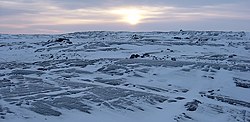Whale Cove
ᑎᑭᕋᕐᔪᐊᖅ Tikirarjuaq | |
|---|---|
 | |
| Coordinates: 62°10′15″N 092°34′40″W / 62.17083°N 92.57778°W[1] | |
| Country | Canada |
| Territory | Nunavut |
| Region | Kivalliq |
| Electoral district | Arviat North-Whale Cove |
| Government | |
| • Type | Hamlet Council |
| • Mayor | Percy Kabloona |
| • Senior Administrative Officer | Brian Fleming |
| • MLA | John Main |
| Area (2021)[4] | |
| • Total | 273.89 km2 (105.75 sq mi) |
| Elevation | 40 m (130 ft) |
| Population (2021)[4] | |
| • Total | 470 |
| • Density | 1.7/km2 (4/sq mi) |
| Time zone | UTC−06:00 (CST) |
| • Summer (DST) | UTC−05:00 (CDT) |
| Canadian Postal code | |
| Area code | 867 |
| Website | http://www.whalecove.ca/ |
Whale Cove (ᑎᑭᕋᕐᔪᐊᖅ in Inuktitut syllabics) (Tikirarjuaq, meaning "long point"), is a hamlet located 74 km (46 mi) south southwest of Rankin Inlet, 145 km (90 mi) northeast of Arviat, in the Kivalliq Region, Nunavut, Canada, on the western shore of Hudson Bay.
The community is named for the many beluga whales which congregate off the coast. Many of the inhabitants hunt these whales every fall and use their by-products for their oil and food. Whale Cove, initially settled by three distinct Inuit groups (one inland and two coastal), is a relatively traditional community: 95% Inuit,[6] who wear fur, hunt, fish, eat raw meat and fish. Several bowhead whales may appear in the area as well.[7] Whale Cove is on the polar bear migration route.
Local Inuit regularly travel by snowmobile in the winter or by boat in summer months between the hamlet of Rankin Inlet and Whale Cove, a distance of 100 km (62 mi). The terrain is Arctic tundra, this consists mostly of rocks, mosses and lichens.
- ^ "Whale Cove". Geographical Names Data Base. Natural Resources Canada.
- ^ "Municipal Election Results 2019-2020" (PDF). Elections Nunavut. Retrieved 21 January 2023.
- ^ "2021 General Election" (PDF). Elections Nunavut. Retrieved 21 January 2023.
- ^ a b Cite error: The named reference
2021censuswas invoked but never defined (see the help page). - ^ Elevation at airport. Canada Flight Supplement. Effective 0901Z 16 July 2020 to 0901Z 10 September 2020.
- ^ "Census Profile, 2021 Census of Population - Profile table - Whale Cove, Hamlet (HAM), Nunavut, [Census subdivision]". 6 December 2022. Retrieved 21 January 2023.
- ^ Cosens & Innes 2000.

